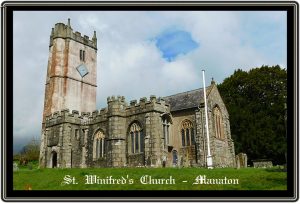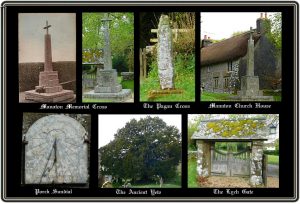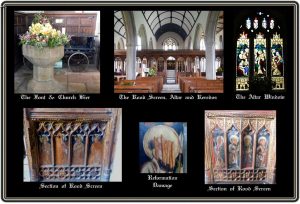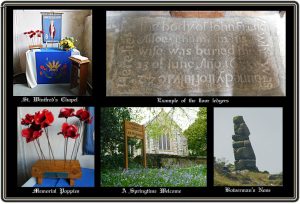
It’s many years since I last went to St. Winifred’s church at Manaton and that was just a fleeting visit so on a typical Dartmoor day with heavy showers interspersed with bursts of sunshine I called in again. On walking through the lych gate the sun burst through the grey billowing clouds and lit up the twenty three metre tower with its white lime-based rendering. This seems a stark contrast to the grey granite of the main building but as the saying goes – “everything for a reason.” The original tower dates back to around 1500 but on the 13th of December 1779 a mighty thunderstorm passed over the church and lightening struck the tower. So powerful was the impact that the tower was virtually rent in two with the total collapse of the north wall. The belfry also suffered severe damage so much so that some of the bells came crashing through the roof of the nave. Further destruction was caused by falling masonry to the altar and the eastern end of the chancel along with the majority of the medieval glass windows. Not to be defeated by such a catastrophe the folk of Manaton manged to repair the church pretty much as it stands today. But back to the ‘gleaming tower’, originally the granite stonework would have been rendered but at some point in the late 1800s the rendering was removed this then led to serious damp problems. In order to prevent further damage the tower was given a ‘new coat’ of a concrete based render in 1931. By the year 2000 and thanks to the vagaries of the Dartmoor weather it was necessary to once again re-render the tower, this time with a lime based render which explains the ‘gleaming tower’ appearance of today.
There are several things of interest in the churchyard, the first of which can be seen in all its glory on the right as one passes through the lych gate. The venerable yew tree is thought to be between two and three hundred years old and is said to be the largest of its kind on Dartmoor which seems a fair claim. As with any valuable asset it’s always best to have an insurance policy and in the case of the yew tree it comes in the form of young yew tree growing nearby and which has been propagated from a cutting taken off it’s mighty parent. This ‘youngster’ was planted in 2000 in order to commemorate the new millennium.
Again, just inside the churchyard stands Manaton’s war memorial which was erected in 1921 and originally carried the names of those killed in the First World War, the memorial was later updated with those who fell in the Second World War. As can be seen below, originally the memorial was topped with a much simpler cross that the stone one which adorns it today. At the western end of the churchyard stands another much older granite cross with an interesting legacy. The ‘Heathen Cross‘ was once removed by the then rector in 1841 for its association with what he deemed to be pagan practices. In 1909 a workman discovered the missing cross built into a nearby wall, it was then taken back to the churchyard and restored to where it stands today. On the southern and eastern walls of the tower is a clock face both of which were gifted to the church to the memory of Charlotte Kitson in 1934. Whilst in the churchyard I noticed a couple wandering around the cricket field and was hailed over to them, apparently they were desperately looking for Bowerman’s Nose. Sadly it was then a case of “don’t shoot the messenger” as I pointed to the famous rock idol standing proud in the far distance. The couple were obviously determined to find old Bowerman as they then asked for directions. I suggested they headed off down the road to Hayne Cross and pick up the path which would take them to Hayne Down and Bowerman’s Nose. At this point the heavens opened and I took my leave for the shelter of the church, noticing as I went the couple trundling off down the road under the shelter of a minuscule flowery umbrella.
On approaching the church door the first thing to see is the old sun dial, a simple slate affair which unlike many of Dartmoor’s sun dials has no motto inscribed on it and is of an unknown date. On entering the church ones eyes are immediately drawn to the left where stands an impressive nineteenth century font which on my visit was still festooned with Easter flowers. Behind this stands the old church bier which was used to carry coffins to the gravesides and was last used in the 1950s. Standing in the crossing the first impression of the interior is of how light it is unlike some of Dartmoor’s churches. Immediately the eyes are drawn towards the altar with its impressive reredos. This was presented to the church in 1897 and was gifted by the Ffrench family, it was designed by G. Prynne and painted by E. Prynne. The wooden panels depict scenes from the nativity and the crucifixion and are fashioned in the high Italian style. Walking towards the altar one is greeted by a splendid rood screen which is estimated to date back to around 1500. Although the original loft which once stood on top of the screen has gone much of the original 16th century paintwork is still visible. The screen has undergone two stages of restoration, one in the late 1880s and a more recent one in 1981. As well as the twelve apostles other saints depicted on the panels are; St. Helena, St. Edmund King and Martyr, St. Bartholomew, St. Blaise, St. James the Great, St. Paul, St. Andrew, St. Gregory and St. Jerome. On closer inspection what soon becomes evident is that at some point in time somebody for some reason took a distinct dislike to the depictions as all the figures have had their faces scratched or carved out. There are two possible reasons for this, the Reformation of the 1500s when the Privy Council demanded that all Catholic images and icons be destroyed or at the second instance in the 1640s when similar actions took place. However the consensus of opinion points the finger at the Reformation of the 1500s for the damage. It was reported in the Totnes Times that in the March of 1907; “the way over the rood screen was fully opened. Some years ago the entrance door was discovered on the inside of the south wall of the chancel. This led to a staircase and another door on the screen. For some time traces of the door have been seen on the inside of the north wall. An opening was made, which revealed a staircase leading to a door in the nave on the west side of the screen. Thus the priest must have entered on the south side, crossed over and descended on the north side.” This refers to the one-time rood loft which sat over the rood screen. To the right of the altar is St. Winfred’s Chapel where a memorial to the nine men from Manaton who fell in the First World War. Representing each one of those men is a ceramic poppy from the 2014 Tower of London ‘Blood Swept Lands and Seas of Red’ installation. There are several ledgers set into the floor around the rood screen most of which are still fairly legible and date back to the 1600s.
In 1923 a huge restoration project was announced under the auspices of the architect Sir Charles Nicholson, it was estimated the cost of which would be £4,000. The villagers began holding various fund raising activities which allowed the work to commence and in 1924 the church closed its doors for twelve months. During this time the whole of the south aisle roof was replaced and the main one repaired. A new screen was provided at the west end of the church along with new panelling for the sanctuary and new oak pews were also installed. In the April of 1925 the Bishop of Exeter re-opened the church by holding a well attended service followed by special tea in honour of the occasion.
Over the centuries St. Winifred’s Church has had its fair share of controversial priests which left their mark not only on the church itself but also the local community. In the 1600s the Reverend John Nosworthy took over the living at Manaton. Being a Dissenter did not go down too well with the parishioners and in 1660 he was physically removed from his station. Then in 1841 the Reverend John Charles Carwithen decided to remove the ‘Heathen Cross’ much to the annoyance of the villagers. Right up until 1848 when the Reverend left Manaton nobody knew exactly what had happened to the ancient cross until it was later discovered.
Next came the Reverend J. C. B Sanders along with his wife who of all the incumbents was by far the lost unpopular. In the July of 1897 the Manaton parishioners were organising a celebration of Queen Victoria’s Diamond Jubilee. As part of this they wanted the church bells to be rung but for some reason the Reverend flatly refused the request. Various appeals by the church wardens, the bell ringers and Jubilee Committee were made but still Sanders refused and ordered the sextant to give him the keys to the bell tower which was then duly locked. On the day of the Jubilee the Reverend along with his wife and a party of visitors drove out of the parish in a convoy of carriages probably to distance themselves from any trouble. But the festivities went ahead with a service on the village green followed by tea, dinner and sports. As night fell the villagers lit a huge bonfire on the rocks behind the church. A procession was then led around the village and up to the rock with people carrying effigies of Mr. and Mrs. Sanders which were then ceremoniously burnt in the fire. As the effigies were burning it was alleged that a mock Holy Communion was held and prayers said for the repentance of the Reverend and his wife. Later that night some men went down to the church and demolished a porch which Sanders had erected over the vestry door and also removed some of the gates on his land. Following the Jubilee celebrations the bell ringers went on strike refusing to ring them until Sanders left the parish.
In 1898 there was a huge argument regarding what was deemed to be an illegal Vestry Meeting previously conducted by Sanders. Accordingly the Churchwarden, Mr. Cummings deemed fit to put up a notice which announced another meeting at which various church matters were to be discussed. As a precaution he requested that a local constable be present when the notice went up. No sooner had the notice been pinned up in the church than the Rev. Sanders charged in a tore it down. The following conversation was then reported; “Mr. Cumming – why did you do that? Sanders – because you have no right here. This is my church, I am master, who are you? Mr Cumming – I am the church warden! Sanders – No you are not! Mr. Cumming – Yes I am, and if you doubt it refer to the archdeacon, and he’ll put you right! Sanders – I don’t care for the archdeacon! The Mrs. Sanders enters the affray – Hullo, what’s this? We don’t care anymore for the archdeacon anymore than we do for you! By this time the churchwarden was in the process of putting up a replacement notice for the first one that was torn down. Mrs. Sanders continued – Why my dear, they say our vestry meeting was illegal. Stuff, tear it down. Don’t hold any service dear; send the people home. Then to the constable – Its a shameful thing, send them home! The constable – I have nothing to interfere about! At this point a lady and her two daughters came to the church on order to attend the daily service and met up with a Miss Sweetland who was Sanders’ aunt. As they went to enter Mrs. Sanders carried on with her tirade – Don’t speak to her aunt, she is no friend of ours; she’s against us! To which the woman replied – I think you must be a very wicked woman to make such a statement, and here, of all places. It is a remarkable thing that people cannot pass into church without being insulted by you! This is the second time you have served me so! Mrs. Sanders – Who are you, you are against us! By this time the churchwarden had pinned his second notice to the board but then the reverend stormed back into the porch, tore the board off the wall and dashed back inside. As he did Mrs. Sanders said – Hold the service dear, get through it best you can! The whole basis of this dispute was the refusal of Sanders to hand over various church documents and ledgers possibly for the reason listed below.
In the July of 1909 the Reverend Sanders then submitted a letter to the Totnes Times complaining that his church had been desecrated. It seems that a stool was removed from his pulpit and placed on the visitor’s book and a written prayer to the virgin was stuck in the top rail of the pulpit. Over the coming years both the fabric of the church and rectory fell into serious neglect that in 1917 the Rural Dean came to visit the Reverend. His purpose was to enquire as to why the church was in such a state of disrepair and to obtain information on other church property. In the possession of Sanders was the Rural Dean’s Book in which an entry was made by a previous Rural Dean in 1846 stating that the old and new altar vessels were in good order. It later transpired that a silver chalice was missing and on visiting a local dealer where it was revealed that they had purchased an Elizabethan silver chalice for £50 from Sanders. Various other documents were found all of which stated the presence of the chalice belonging to the church. In the May of 1918 the Bishop, Archdeacon and the Rural Dean revisited Manaton in order to get an explanation of the chalice’s disappearance. Sanders denied all knowledge of the chalice but admitted selling an old pewter flagon to the dealer’s agent and signed a written petition to that effect. On the 15th of January 1920 a Consistory Court was held where charges of an immoral act, immoral conduct and an offence against the laws ecclesiastical, contrary to section 2 of the Clergy Discipline Act were investigated. The exact charges being that on the 14th of February 1915 Sanders did fraudulently convert to his own use a silver chalice, with which he was entrusted and had received for safe custody. Additionally that Sanders did sell the chalice to a Mr. Vidler who was the agent for Messrs. Iredale & Co of Torquay. He was also charged with the fact that he falsely and with intent stated to the Rural Dean that he had not sold the chalice. Sanders did not attend the Consistory Court as he stated his wife was ill. After a lengthy process the Chancellor of the court stated that he would be submitting a his report to the Bishop of Exeter in due course. On the 29th of January 1920 most local newspapers reported that the Reverend John Charles Burch Sanders had been deprived of the living at Manaton and all ecclesiastical promotion in the diocese for selling the Elizabethan chalice and for making false representations to the Bishop and Rural Dean. So finally after twenty odd years peace and harmony was restored to the church and village on Manaton.
There is one small aside to the determination of Manaton folk and their celebrations and which concerns the wedding of Prince Albert in 1863. It was felt that such an occasion should not pass without a Royal Salute. There was a slight problem insomuch as the village didn’t have any canons with which to give the salute. Their solution – go to the high rock behind the church, drill twenty one holes. Then pack these with powder and attach different length fuses which would allow enough time between charges to simulate canon fire and as it transpired this plan allowed the necessary 21 ‘gun salute’ to be given.
So all in all an interesting church that has seen various tumultuous occasions and has managed to survive them all. Before ending it might be useful to quickly mention the St. Winifred dedication. Nicholas Orme in his book – English Church Dedications suggests that the church was dedicated to; “George from at least 1486 until the Reformation, it was then forgotten. Winifred since 1742…” p.180. But who was Winifred? There are two ideas but the most popular one is that Winifred was the daughter of a Welsh nobleman living in the 12th century. She had a suitor named Prince Caradoc who took none to lightly the fact that she decided to become a nun and so in a fit of temper he beheaded her with his sword. Fortunately her mother’s sister St. Beuno reunited the head with the body and Winifred was restored to life. In an act of reprisal St. Beuno prayed to God for vengeance and her prayer was answered when supposedly the earth opened up and swallowed Caradoc. It was also said that on the spot where Winifred’s head fell to the ground a holy well issued forth. Whatever the reason for the dedication it must be said St. Winifred does not have many other associations with Devon Churches. There is another St. Winfreds at Branscombe and another at Seaton.
After visiting Manaton church I decided to drive over to Hound Tor and on entering the car park who should I see ambling along the road coming from Hayne Cross but the couple asking for directions to Bowerman’s Nose. They clearly missed going onto Hayne Down as they then proceeded back along the road going passed Swine Down – hope they got there in the end?

N. Orme, 1966. English Church Dedications. Exeter: Exeter University Press.
C. Stewart & J. Rogers, 2016. The history of St. Winifred’s Church – Manaton. publisher unknown.
 Legendary Dartmoor The many aspects past and present of Dartmoor
Legendary Dartmoor The many aspects past and present of Dartmoor




